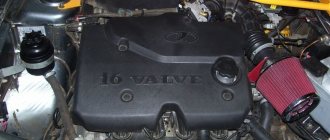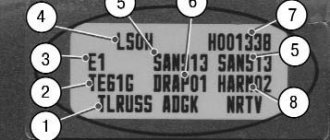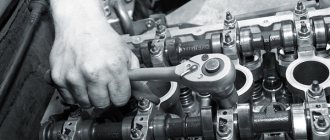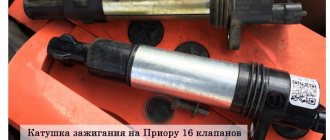Any extraneous noise in a car engine often makes owners feel wary. And even if these sounds do not affect driving performance in any way, their very appearance makes the driver think about diagnostics. Many cars have knocking pins when accelerating, but this problem is often ignored. The sound appears when the car picks up speed. If you do not pay attention to this in time, much more serious problems arise. At the same time, car enthusiasts cannot determine the reasons for the appearance of knocking noises, nor can they fix this problem on their own. Let's look at the reasons for these sounds that are unpleasant to the driver's ear, and also find out how to fix these problems with the engine.
Knocking fingers
A ringing metallic sound may be heard from an engine that is running under load. They disappear when reaching a certain speed. Old school mechanics will say it's the "fingers" chattering during acceleration. However, the driver will be surprised, and he will be completely right: the sound has nothing to do with the “fingers” installed in the pistons.
Why "fingers"?
The combustion process of the combustible mixture in a fully operational engine proceeds sequentially. A flame flares up near the spark plug, and gradually it fills the entire cylinder. But there is another combustion option - detonation. The explosion of the fuel mixture in the combustion chamber occurs abruptly. This increases pressure and temperature. This very explosion is called detonation. That's why the driver hears a knock - it comes from the blast wave. Proper combustion implies a fire propagation speed of up to 30 m/s. The gas pressure increases gradually. With this type of combustion, the flame fills the cylinder gradually. The gases press gently on the piston. There is no knocking of gas against the walls of the combustion chambers, since there is no explosion. If the burning rate is higher, then these are the prerequisites for detonation. By the way, this phenomenon is very harmful to the engine.
Causes
If we consider this effect only on the engines of VAZ cars, then it can occur on any of them - both an obsolete engine of model 2106, and a modern installation of the same version 2114, etc.
There are certain reasons for VAZ detonation, and they are as follows:
- Incorrect proportions of the combustible mixture. In an overly enriched combustible mixture, after entering the cylinder, due to exposure to high temperatures in remote corners of the combustion chamber, oxidation processes may occur, which are the root cause of detonation;
- Ignition timing violation. As the angle increases, all processes in the cylinders take place even before it approaches TDC. Hence the high pressure and temperature, and the appearance of chemical reactions with part of the mixture.
- Octane number. The lower it is, the higher the likelihood of detonation. This is all explained by the fact that low-octane gasoline is more susceptible to reactions.
- High compression ratio. An increase in this parameter above the norm leads to increased pressure and temperature in the cylinders, which are catalysts for the occurrence of reactions.
All the described factors for the appearance of this effect are the same for all gasoline engines, therefore the reasons for detonation of a carburetor engine are the same as for an injection engine.
Detonation - what is it?
If the “fingers” knock during acceleration, this indicates detonation in the engine. This is the name given to an instantaneous and very destructive in its force explosion of any flammable substance after an impact or activation of a detonator. This is the definition according to Ushakov’s dictionary. Detonation of flammable substances for car engines is the rapid burning out of a mixture of gasoline and air. Occurs when the engine operates under load at low speeds and low-quality fuel. This process is accompanied by knocking, vibration, and increased temperature. As a result, the “fingers” knock during acceleration (including the VAZ-2112).
Symptoms of a problem
It is quite difficult to immediately determine the failure of the motor control; you need to feel and know your car well in order to quickly feel the malfunction. The “Check Engiene” warning light does not light up in the event of a malfunction, but an error with the name “Low signal level of the knock sensor” is stored in the ECU; this error is numbered 0327.
Symptoms:
- Increased fuel consumption is quite difficult to notice quickly;
- Increased engine vibrations;
- More sluggish and longer acceleration of the car;
Typical causes of ringing “fingers” during normal operation of the internal combustion engine
If the “fingers” knock during acceleration in the Kalina, the mass air flow sensor may have failed. If it is not working correctly, then the ECU will receive incorrect information and issue incorrect commands. Another reason is an incorrectly set ignition timing. For this reason, the point at which the fuel will burn maximum is approaching TDC. This leads to increased pressure in the combustion chamber. If the “fingers” knock when accelerating on a Ford Focus, then the knock damping sensor may have failed. It's definitely worth checking this item. If it stops working, it should be replaced.
Replacing the sensor
We figured out how to check the knock sensor of a VAZ-2114 or any other model. Please note that this sensor cannot be repaired and if it is faulty, it must be replaced.
Replacing the VAZ-2114 knock sensor is a simple operation, but it can be difficult due to poor access to it (16-valve engines). To change, you just need a new element and an open-end wrench of the appropriate size.
Before unscrewing the mounting bolt, you must first disconnect the block with wires. Then the bolt is unscrewed, the old sensor is removed, and a new one is installed in its place and securely fixed with the same fastener. And only after that the block with wires is connected.
Why does detonation occur in engine cylinders?
Experts identify several main reasons why fuel detonates in the engine.
- First of all, it is worth immediately highlighting the use of low-octane gasoline in units with a high compression ratio. Simply put, the octane number of gasoline (AI-92, 95 or 98) actually indicates its resistance to detonation, and not its quality, as many people mistakenly believe.
The use of fuel with an inappropriate octane number for a particular engine naturally leads to the fact that the fuel-air charge detonates under strong compression. Let us also add that simple engines that do not have an ECM and a knock sensor are at greater risk.
- Engine coking. It is important to understand that modern engines not only in foreign cars, but also in domestic cars are very different from their analogues from the times of the USSR. In a nutshell, if the engines on the Moskvich 2141 model had a compression ratio of about 7 units and worked normally on any fuel, today the units have from 9 to 11 or more units.
- Violation of the mixture formation process. In this case, a too “rich” mixture, in which there is a lot of fuel in relation to the amount of air, may begin to detonate.
Note that such detonation can be short-term and often goes unnoticed by the driver, however, it is impossible to say that there is no harm to the engine.
- Ignition timing (IDA). In simple words, the ignition angle determines at what point the spark will be supplied to the combustion chamber. If we consider that normally fuel does not explode, but burns, then it becomes clear that the combustion process also takes some time.
In this case, it is important to ensure that the maximum gas pressure on the piston, which is formed as a result of the combustion of a portion of fuel, occurs precisely at the moment of the working stroke of the piston. This is the only way to effectively transfer the energy of the expanding gases through the piston to the crankshaft.
To do this, the spark can be applied a little earlier than the moment the piston reaches top dead center (TDC). During this time, the fuel will have time to ignite, and the expansion of gases and an increase in pressure on the piston will occur just at the moment when the piston has already reached TDC and then goes down.
- Design features of the combustion chamber. It happens that some engines are initially prone to detonation. In some cases, the reason is the design of the combustion chamber itself, the implementation of its cooling, etc.
Another culprit may be pistons that have an unsatisfactory thermal balance (for example, the piston bottom is thickened closer to the center, which noticeably worsens the quality of excess heat removal). One way or another, the risk of detonation on such engines is much higher.
- Engine overheating. If you pay attention to the previous point, it becomes clear that an increase in temperature in the combustion chamber is the cause of detonation. It is quite obvious that a decrease in the efficiency of the cooling system can lead to the engine overheating.
Causes of sensor malfunction and ways to check it
The knock sensor on cars rarely fails, including the Priora. However, VAZ-2170 owners can often detect a DD malfunction error. And the reasons for its occurrence may be the following factors:
- Damage to the wiring that connects the sensor to the ECU.
During operation of the car, damage to the insulation may occur, which will ultimately affect the signal level. A normally operating sensor produces a signal from 0.6 to 1.2V. - Oxidation of contacts.
The device is located on the cylinder block and is exposed not only to moisture, but also to aggressive substances in the form of engine oil. Although the sensor contact is sealed, a connection failure cannot be ruled out, which leads to oxidation of the contacts in the sensor or chip. If the wire on the DD is in good condition, then you need to make sure that the contacts in the chip and on the sensor connector are intact. - Violation of the integrity of the body. It should not have cracks or other defects.
- Damage to internal elements.
This happens extremely rarely, and you can verify the suitability of the device by testing. The piezoceramic element or resistor may fail. To do this, you will need to perform a sensor test. - The connection between the sensor and the cylinder head is not reliable enough.
It is recommended to pay attention to this point to all owners of Priora cars whose BC displays error P0326 . The device is fixed with a bolt that has a shortened thread. This thread does not rest against the block with its end part, therefore vibrations from the block with a normally operating motor are not enough to generate the minimum permissible signal of 0.6V. As a rule, a sensor fixed with such a bolt produces a low voltage of 0.3-0.5V, which is why error P0326 occurs. The problem can be corrected by replacing the bolt with a stud of the appropriate size.
Having considered the main symptoms of a malfunction of the knock sensor on a Priora, you should resort to checking its serviceability. To do this, you need to arm yourself with a multimeter. The method for checking the device is quite simple, and it is much more difficult to remove the sensor from the car than to check its suitability. The check is performed as follows:
- Vehicle-mounted sensor. You can check the device without removing it, which is especially important for Priora cars with 16-valve engines, where access to the device is limited. To check the sensor, you must perform the following steps: get close to the sensor in order to be able to strike on or near it. We ask the assistant to start the engine, after which we strike the sensor with a metal object. As a result, the sound of the engine should change, which indicates that the ECU has set the ignition later. If such changes can be traced, it means that the device is working properly and is suitable for use. This also indicates that the sensor circuit is working properly.
- Checking the voltage on the sensor removed from the car. Connect the multimeter probes to its terminals and switch the device to the 200 mV voltage measurement mode. This is necessary in order to fix the voltage on the device. Next, lightly hit the metal part of the sensor with a steel object (or press the metal part with your fingers), and observe the readings. Their changes indicate the suitability of the device.
- Checking resistance. A working DD on Priora and other VAZ models has a resistance that is equal to infinity, which is quite normal, since when not working the piezoelements are not connected to the contact washers. We connect the device to the DD terminals, setting the measurement mode to MOhm, and take measurements. In the non-working position, the value will tend to infinity (on device 1), and if you start to influence the sensor, squeezing it or hitting it with a metal key, the resistance will change and amount to 1-6 MOhm. It is important to understand that sensors for other cars have different resistance values.
- Check the condition of the wires and contacts of the chip. It is checked visually, and if damage to the insulation is detected, the chip must be replaced.
- Checking the integrity of the circuit. To do this, you need to arm yourself with a multimeter with a continuity mode, and test the wires from the chip to the terminals on the ECU. The pinout diagram for the knock sensor on the Priora will help with this.
Knock sensor pinout diagram
The above presented pinout diagram for the Priora knock sensor is appropriate for January and Bosch brand controllers. If the wires are not damaged, and error P0325 is displayed on the BC, then this indicates a failure of the resistor. Some craftsmen eliminate such a breakdown by soldering a resistor of the appropriate size between the wires in front of the chip. However, this is not recommended, and it is much easier and more reliable to buy a new sensor and replace it. Moreover, the cost of the product is 250-800 rubles (depending on the manufacturer).
This is interesting! If checking the sensor and wires shows that there are no defects, but the error message on the BC about a device malfunction continues to light up, then you should resort to replacing the fastening element, that is, replace the bolt with a stud with an extended thread. How to do this correctly, read in the next section.
How to eliminate engine detonation
So, having considered the main causes of engine detonation and having understood what it is, we can move on to how to get rid of this phenomenon. Let's start with old internal combustion engines. At the very beginning, you should exclude overheating of the engine, as well as refueling with low-quality or unsuitable fuel, and check the spark plugs.
The solution is temporary, since you cannot drive for a long time with a reduced ignition angle (the exhaust valves will burn out as a result of an increase in the temperature of the exhaust gases), but getting to the service center on your own is quite possible.
However, while driving, you need to constantly ensure that there is no characteristic “ringing” in the engine. You can also install a so-called electronic octane corrector on an old internal combustion engine to avoid manipulations with the distributor. Let us also add that, as practice shows, many owners of carburetor cars prefer to install electronic ignition.
As for more modern engines, injection units are equipped with standard solutions to avoid or minimize the risk of detonation. We are talking about an engine knock sensor (DE), which detects its occurrence. Then the corresponding signal is sent to the ECU.
Then the control unit independently adjusts the ignition timing taking into account the data received from the DD. Moreover, the possibility of such adjustment is, on average, an angle shift of 2 – 5 degrees. If it is not possible to get rid of detonation in this way, the ECU records the error and writes it to its memory, a “check” may light up on the instrument panel, the engine goes into emergency mode, etc.
It becomes clear that in this case, the driver at the initial stage needs to start by checking the knock sensor, and also read errors from the ECU memory. This can be done as part of computer engine diagnostics. You can also perform the check yourself (if you have a special diagnostic scanner adapter for the OBD connector and a smartphone/tablet or laptop with pre-installed software).
How to check engine performance using spark plugs. The main signs of engine malfunctions: the appearance of black, gray, red and white carbon deposits on the spark plugs.
Signs for determining the correct ignition timing. Consequences of an incorrectly configured OZ, methods for setting the ignition.
Purpose and design of the knock sensor. The main causes of detonation, types and operating principle of the sensor.
Why does the fuel-air mixture detonate in the combustion chamber? Reasons causing detonation. Consequences of detonation combustion of fuel in internal combustion engine cylinders.
Why does the engine overheat? What should the driver expect and what damage may occur if the engine overheats. What to do if the internal combustion engine overheats.
Common engine cooling system failures: water pump, thermostat, radiator, cooling fan and others. How to determine the reasons yourself.










